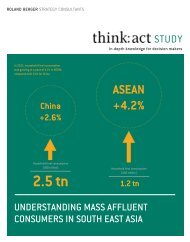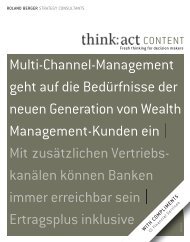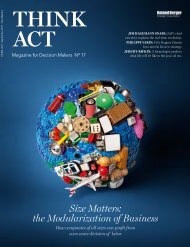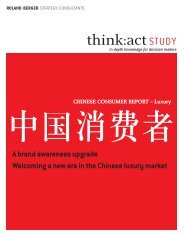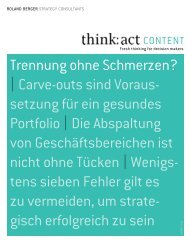Automotive inSIGHTS 1/2007 - Roland Berger
Automotive inSIGHTS 1/2007 - Roland Berger
Automotive inSIGHTS 1/2007 - Roland Berger
Create successful ePaper yourself
Turn your PDF publications into a flip-book with our unique Google optimized e-Paper software.
AUTOMOTIVE<br />
<strong>Automotive</strong> Competence Center customer magazine No. 01_<strong>2007</strong><br />
> Low cost cars: Who will make the most of the growing market?<br />
> Suppliers: On average more profitable than OEMs<br />
China‘s market for<br />
low cost cars is booming
Editorial<br />
Contents<br />
"INSIGHTS":<br />
<strong>Automotive</strong> Insights,<br />
model year <strong>2007</strong><br />
Dear Reader,<br />
New model year, new features. What is<br />
good for the automotive industry is good<br />
for <strong>Automotive</strong> Insights as well: We have<br />
relaunched our magazine to make room<br />
for more true insights into the latest<br />
trends and developments in our industry.<br />
From now on we will start every issue<br />
with a look around the world: <strong>Roland</strong><br />
<strong>Berger</strong> Consultants will report on the<br />
newest topics in their markets. This time<br />
we take a look at Russia, the US and<br />
Japan. News and interesting publications,<br />
a story on a famous car and two factpacked<br />
reports on new studies follow.<br />
In this issue we offer insights into the<br />
development of the markets for low cost<br />
cars and research why suppliers on average<br />
work more profi tably than the OEMs.<br />
We hope you will enjoy reading our new<br />
<strong>Automotive</strong> Insights.<br />
Sincerely,<br />
Ralf Kalmbach<br />
2 News<br />
2 „Insights“: A look<br />
around the world<br />
2 USA North American<br />
suppliers: the good, the<br />
bad and the ugly<br />
3 Russia Dilemma for<br />
western suppliers<br />
3 Japan Never walk alone:<br />
Entering the Japanese<br />
market<br />
4 Teaming up to exploit<br />
potential OEMs and<br />
dealers can achieve<br />
more working together<br />
4 Famous cars<br />
The Aston Martin DB 5<br />
4 Books & Studies<br />
5 Studies<br />
5 Low cost cars<br />
A <strong>Roland</strong> <strong>Berger</strong> study<br />
shows: Production<br />
will grow by 4 million<br />
units by 2012<br />
8 <strong>Automotive</strong> suppliers<br />
drive away with the<br />
profit A survey of<br />
<strong>Roland</strong> <strong>Berger</strong> Strategy<br />
Consultants and investment<br />
bank Rothschild<br />
Published by: <strong>Roland</strong> <strong>Berger</strong><br />
Strategy Consultants GmbH,<br />
Mies-van-der-Rohe-Straße 6,<br />
80307 München<br />
Responsible: Ralf Kalmbach<br />
and Ralf Landmann<br />
Editors: Susanne Tebartz,<br />
Dr. Heidi Sylvester<br />
Photographs: Renault, VW, GM,<br />
Chery, Picture Alliance, Magna<br />
Steyr AG, <strong>Roland</strong> <strong>Berger</strong>, Rothschild<br />
GmbH<br />
Layout: Jens Kaiser<br />
Printed by: Girodruck, Hamburg<br />
Circulation: 3,500. Published<br />
three times a year, no reprints<br />
without prior permission of the<br />
publisher<br />
USA<br />
Growing pains in Russia,<br />
new rules in the US,<br />
chances for European<br />
suppliers in Japan – a<br />
look around the world<br />
North American Suppliers:<br />
the good, the bad and the ugly<br />
The performance of the North American<br />
automotive supplier industry is becoming<br />
increas ingly polarized. True, the industry<br />
as a whole has suffered, as median<br />
Return on Assets (ROA) among 33 large,<br />
public suppliers has fallen from 5 percent<br />
in 2000 to 1 percent in 2005.<br />
However, many suppliers are performing<br />
well. In 2005, more than half of these<br />
suppliers enjoyed Return on Equity (ROE)<br />
above 10 percent, while the bottom<br />
quartile showed negative ROE. The top<br />
quartile had ROA of 8 and EBITDA margins<br />
of 18 percent, compared to the<br />
bottom quartile‘s -14 percent ROA and<br />
EBITDA margins of -2 percent. The<br />
volume reductions at GM, Ford, and<br />
Chrysler, increasing price pressure, and<br />
rising raw material prices create a perfect<br />
storm in the industry. Bankruptcies<br />
became common among US suppliers.<br />
In this challenging environment, there is<br />
strong interest from private equity fi rms<br />
and hedge funds to invest in suppliers.<br />
They will bring in capital and turn around<br />
skills, and will drive industry consolidation.<br />
Mega-suppliers are on the horizon,<br />
as weaker players either consolidate or<br />
drop out of the business. Indeed, some<br />
mega-suppliers may move further up the<br />
value chain and begin assembling their<br />
own complete vehicles.
News | <strong>Automotive</strong> Insights | 3<br />
What's going on around the globe<br />
RUSSIA<br />
Dilemma for western suppliers<br />
The Russian car market grew by 20<br />
percent in 2006. Profi teering from the<br />
growth are mostly foreign carmakers.<br />
To secure their share in the booming<br />
market many foreign car companies are<br />
investing in production sites in Russia.<br />
But since they regard it as a high risk<br />
investment, most OEMs are building only<br />
relatively small factories with a capacity<br />
of 50,000 to 70,000 vehicles per year.<br />
Suppliers have to follow the OEMs<br />
Since local Russian suppliers are still<br />
trying to catch up with technological<br />
developments, OEMs have asked their<br />
sup pliers from home to follow them into<br />
Russia and build up capacities as well.<br />
But these suppliers face a di lemma by<br />
entering Russia: The capacity of the OEMs<br />
Russian factories is so low that they can't<br />
keep the suppliers production plant busy,<br />
and they don't reach the critical mass.<br />
Joint ventures with local suppliers<br />
Since OEMs expect them to follow into<br />
Model of new Volkswagen plant in Kaluga: Siemens is coming, too<br />
Russia, many western suppliers are exploring<br />
the opportunities for joint ventures<br />
with local companies. Westerners would<br />
deliver the technology and manage the<br />
joint project, the local supplier the capacity<br />
and manpower.<br />
There is a downside<br />
Siemens has set up such a joint venture<br />
with local Auto electronica in Kaluga,<br />
where Volkswagen is building its Russian<br />
factory. Many other western suppliers<br />
are expected to follow the example of<br />
Siemens. The joint ventures have, however,<br />
a downside: With the injection of<br />
state-of-the-art technology and modern<br />
management techniques the western<br />
suppliers are teaching their Russian<br />
counterparts. It may not take too long<br />
until joint venture partners will become<br />
competitors.<br />
JAPAN<br />
Never walk alone: Entering the<br />
Japanese market<br />
Local production by Japanese OEMs has<br />
nearly doubled since 1999. But European<br />
suppliers trying to participate in the booming<br />
market meet diffi culties. There are several<br />
ways to Japan: First of all, they have to meet<br />
the expectations of Japanese OEMs. Functionality<br />
of product, high quality standards,<br />
local contact for customers, price competitiveness<br />
and a manufacturing location in<br />
Japan are required. To meet these demands<br />
most foreign suppliers form a business alliance<br />
with a local supplier as a fi rst step.<br />
Edscha from Germany for example teamed<br />
up with Oi Seisakujo, a major Japanese<br />
supplier in door hinges for Nissan, in 2001.<br />
Edscha established a joint venture with Oi<br />
Seisakujo in 2003, transferring its Japanese<br />
business to the new company.<br />
Mahle, world market leader in fi lter systems,<br />
took a different path into the market. In<br />
2001, it acquired Tenex, Nissan‘s major<br />
supplier in fi lters. By now Mahle supplies<br />
fi lters to several Japanese OEMs.<br />
Bosch's journey into the Japanese market<br />
has been long. It entered in the 1970s by<br />
supplying licenses to local companies. In<br />
the following years, Bosch founded joint<br />
ventures and acquired shares in local companies.<br />
Step by step it obtained control<br />
of production, development and sales in<br />
Japan. Since 2002, Bosch has integrated<br />
three acquired companies to expand the<br />
brand image, and to increase awareness<br />
among Japanese OEMs.<br />
The reasons why successful suppliers don't<br />
enter the Japanese market alone:<br />
Insider status – the ties between OEMs<br />
and their preferred suppliers are very tight.<br />
Difficulty understanding specifications –<br />
OEMs will only give specifi cations with low<br />
detail level. Without assistance, western<br />
suppliers will fi nd it tricky.<br />
Geographical barriers – time difference<br />
and logistics hinder effective business.
4 | <strong>Automotive</strong> Insights | News<br />
Teaming up to exploit potential<br />
<strong>Automotive</strong> OEMs and dealers can achieve more if they work together<br />
Carmakers are dissatisfi ed with the performance<br />
of their sales organizations, dealers<br />
complain of dwindling sales and pressure on<br />
margins. So how can the two sides collaborate<br />
to deliver sales numbers that are acceptable<br />
to both? <strong>Roland</strong> <strong>Berger</strong> Strategy Consultants<br />
has identifi ed three potent strategies.<br />
1. Lay a firm foundation for success<br />
To do so, both sides must be prepared to give<br />
each other insight into how things work "on<br />
the inside". Successful OEMs make top sales<br />
executives spend several days a year experiencing<br />
everyday working life at one of their<br />
dealers. Conversely, the managers of car dealers<br />
should also gain hands-on experience of<br />
manufacturers' sales planning and network<br />
development activities.<br />
The second step toward superior collaboration<br />
is to establish a sales planning process<br />
based on partnership. For OEMs, this means<br />
planning annual sales for individual market<br />
areas in line with realistic potential, and working<br />
with dealers to clarify how targets are<br />
to be met. Together they implement binding<br />
development plans.<br />
2. Live brand messages<br />
While automakers manufacture vehicles, customers<br />
buy brands. The actual vehicle and its<br />
fi ttings and features is merely one way of injecting<br />
life into the brand, of making the brand<br />
tangible. Advertising and communication are<br />
another way to achieve the same goal. The<br />
most important thing, however, is that all staff<br />
who interface with customers must live out<br />
the defi ned brand values day in, day out.<br />
3. Improve processes at the point of sale<br />
In eight out of ten cases, poor performance<br />
by dealers is what prevents cars from being<br />
sold. Professional dealer behavior is therefore<br />
the key lever to signifi cantly boost sales –<br />
apart from launching new models and expensive<br />
marketing campaigns. OEMs should there -<br />
fore help their dealers to concentrate on the<br />
most important processes. Sales promotion<br />
campaigns, for example, can be made more<br />
effective merely by planning, communicating<br />
and implementing them jointly. A new study<br />
("<strong>Automotive</strong> Sales Champions", see right)<br />
will identify the levers for more successful<br />
cooperation between dealers and OEMs.<br />
Books & Studies<br />
Mastering <strong>Automotive</strong><br />
Challenges<br />
The automotive<br />
industry<br />
is currently<br />
experiencing<br />
a period of<br />
wide-spread<br />
changes: the<br />
disappearance<br />
of traditional markets and<br />
customers, intensifying competition,<br />
increasing innovation and<br />
product complexity, and structural<br />
changes in the automotive<br />
value chain – to name just a few.<br />
Mastering <strong>Automotive</strong> Challenges<br />
provides comprehensive and<br />
practical guidance for managers,<br />
showing them how to tackle<br />
necessary action, benefi cial<br />
for day to day management.<br />
The key issues facing managers<br />
are laid out, followed by case<br />
studies which show how these<br />
challenges can be successfully<br />
overcome. Mastering <strong>Automotive</strong><br />
Challenges is a must-read for<br />
any manager within the industry.<br />
<strong>Automotive</strong> Sales<br />
Champions<br />
Famous cars: 007‘s Aston Martin DB 5<br />
They were sold by millions: The Aston Martin<br />
DB 5, gunmetal gray, fi tted with machine<br />
guns and ejection seat was a big success in<br />
Corgi Toys 1965 range of model cars. The<br />
driver made all the difference: Q gave the<br />
original car to 007 to help in his fi ght with<br />
"Goldfi nger". Since then, boys around the<br />
world think of the Astons as the ultimate in<br />
cool. In recent years Aston Martin launched<br />
an astonishing offensive of new models. The<br />
V8 Vantage, the V12 Vanquish S and the DB<br />
9, heir of Sean Connery‘s car. This spring<br />
the fans of the British brand are eagerly<br />
expecting the new Vantage roadster. And<br />
again Aston Martin became the company<br />
car at MI 6 – the latest 007 is driving Aston<br />
Martin DBS, a thoroughbred sportscar, in<br />
"Casino Royale".<br />
Ultimately cool: 007 with DB5<br />
The Automo tive Compe tence<br />
Center of <strong>Roland</strong> <strong>Berger</strong> Strategy<br />
Consultants together with IBM<br />
is conducting a study on excellence<br />
in sales. Questions looked<br />
at: How to improve operating<br />
effi ciency, how to exceed the<br />
expectations of customers and<br />
dealers, how to turn excellence<br />
into market share gains. Results<br />
are due out in May <strong>2007</strong>.<br />
Interested in the book?<br />
Mail to dana_rehfuss@<br />
de.rolandberger.com
Low Cost Cars | <strong>Automotive</strong> Insights | 5<br />
Low cost cars: The early<br />
bird catches the worm<br />
A market study by <strong>Roland</strong> <strong>Berger</strong> Strategy<br />
Consultants found that production of entry-level<br />
cars will grow by four million units by 2012.<br />
Yes, you can do it! Renault's Dacia Logan was the fi rst<br />
model to show Western Europeans that it really is<br />
possible for them to build cars at a profi t in the low cost<br />
car segment. It defi nitely makes economic sense to take<br />
a closer look at this segment. A recent market study by<br />
<strong>Roland</strong> <strong>Berger</strong> Strategy Consultants found that annual<br />
production of entry level cars (A/B segments) will grow<br />
by four million units between now and 2012. Fresh<br />
demand is springing up not only in emerging markets<br />
such as China and India, but also in the richer western<br />
nations, where the cost of buying and running a car has<br />
signifi cantly outstripped income growth. Carmakers that<br />
res pond swiftly to this trend can look forward to signifi -<br />
cant market opportunities. Low cost cars are defi ned as<br />
automobiles that sell for under EUR 10,000 (or under USD<br />
10,000 in the USA).<br />
The auto industry is currently witnessing developments<br />
that have already been experienced by the aviation, hotel<br />
and textile sectors. With the mid-range price segment<br />
shrinking, companies can only earn money on ex pensive<br />
premium offerings or in the low cost segment.<br />
Incumbent OEMs can rise to the challenge at the low<br />
end of the market by basing their strategies on three key<br />
strengths that we refer to as car, care and core.<br />
Car: Vehicles themselves must, of course, be adapted to<br />
market conditions. They must be based on shared global<br />
platforms and modules used in other models, must also<br />
have low cost features and be built at low cost locations.<br />
Care: Finance, insurance, repairs and maintenance,<br />
warranty fulfi llment and mobility guarantees – these and<br />
other services that are especially important for low cost<br />
vehicles allow established manufacturers to score over<br />
their rivals from emerging markets.<br />
Core: This term refers to the brands that OEMs have cultivated<br />
over decades – the core values that encompass the<br />
product itself (car) and the related services (care). Another<br />
advantage is the broad customer base that reinforces the<br />
brands of traditional OEMs, whereas automakers that<br />
originate from emerging markets are only now beginning<br />
to develop their brands and nurture customer loyalty.<br />
Making an acceptable profi t with vehicles in the low cost<br />
car segment requires a new and different approach and<br />
mindset for most incumbent OEMs. Our research shows<br />
six paradigms to make this strategy work:<br />
> Ensure independence from complex and costly<br />
corporate structures<br />
> Limit dependency on brands<br />
> Stick to basic functionality and don‘t overdo the<br />
features: "value for money" is the key<br />
> Operate a global low cost strategy in development,<br />
sourcing and production<br />
> Target markets such as China, India, Russia and Brazil,<br />
where market conditions and the "rules of the game" vary<br />
> Establish potential partnerships to cover all the core<br />
competencies required for a low cost car strategy,<br />
including leveraging shared (low cost) components<br />
and infrastructure. This is vital to keep a cap on costs<br />
Selecting the right target market and gaining an in-depth<br />
understanding of changing consumer behaviors and pre-<br />
Car costs vs. real wage index in Germany<br />
(%, base year 1999 = 100)<br />
125<br />
120<br />
115<br />
110<br />
105<br />
100<br />
95<br />
Car costs<br />
Note: Price index based on operating/purchase costs of passenger cars<br />
Source: German offi ce of statistics; Global Insight<br />
Wages<br />
1999 2000 2001 2002 2003 2004 2005<br />
Dacia Logan:<br />
Proves that<br />
European<br />
OEMs can<br />
build low cost<br />
cars, too
6 | <strong>Automotive</strong> Insights | Low Cost Cars<br />
ferences are two of the most important success factors.<br />
Market selection involves evaluating the regulatory environment,<br />
economic situation and consumer behaviors,<br />
as well as the activities of other OEMs. Further success<br />
factors include adapting vehicles for local markets,<br />
operating platform strategies, extensively standardizing<br />
components and production processes, choosing low cost<br />
locations. To determine which country presents the highest<br />
potential and is most favorable for low cost car production,<br />
it is important to examine each individual market.<br />
In the US, the low cost car segment is expected to grow<br />
to 0.7 million vehicles by 2012<br />
The fi rst low cost car ever made in the USA was Henry<br />
Ford‘s Model T. In its last year of production, the Model T<br />
costed USD 380 – the equivalent of USD 4,200 at today‘s<br />
prices. But cars have become less afford able over time.<br />
Between 1980 and 2003, the average vehicle selling<br />
price rose by 2.2 percent per annum, growing faster than<br />
all but the top 5 percent of US family incomes. At the<br />
same time, high fuel prices are driving down demand for<br />
large SUVs while boosting sales of small cars.<br />
Through 2012, the entry level car segment in Western<br />
Europe will grow by only 0.3 million vehicles<br />
Despite Western Europe‘s prosperity, car prices have outgrown<br />
the wages. As a result, many consumers are becoming<br />
more and more willing to compromise on comfort,<br />
basing car purchase decisions mainly on price instead.<br />
One vivid illustration of this phenomenon is the unexpected<br />
success of Renault‘s Dacia Logan. New models in the<br />
low cost, entry-level segment have considerable potential<br />
if they are fuel-effi cient and inexpensive to run.<br />
Domestic entry-level sales in the Japanese automotive<br />
market are expected to grow from 2.5 million vehicles<br />
in 2006 to 2.6 million vehicles in 2012<br />
Entry-level vehicles in Japan fall into two categories:<br />
Compact cars with engine displacement between 1,000<br />
cc and 1,300 cc and "Kei" or sub-compact cars with<br />
engine displacement of less than 660 cc. The entry-level<br />
vehicle segment, including sub-compact cars, accounted<br />
for 43 percent of the passenger car market in 2005, a<br />
slight increase from the 41 percent market share in 2001.<br />
Japan presents an interesting contrast to other vehicle<br />
markets in that the trend seems to be moving from larger<br />
to smaller vehicles. Foreign OEMs who aim to take advantage<br />
of this trend are nevertheless likely to face numerous<br />
challenges, given the strength of domestic OEMs.<br />
We expect China to be the strongest growth market, with<br />
a volume of 2.6 million entry-level cars by 2012<br />
Currently, the cheapest cars in the world are produced<br />
and sold in China, with MSRPs for many models starting<br />
below EUR 3,000. In China, the upper starting price limit<br />
for A segment cars is around EUR 4,000.<br />
> China‘s entry-level segment is growing rapidly and<br />
represents one third of the market<br />
> The quality of Chinese production is improving and<br />
the market still has plenty excess capacity<br />
> Local Chinese OEMs are gearing up for exports to<br />
developed markets<br />
Global sales forecast of A/B-segment vehicles ('000 units)<br />
4.2%<br />
455 582<br />
Mexico<br />
2006<br />
8,7%<br />
428 705<br />
USA<br />
3.9%<br />
1,204 1,513<br />
Brazil<br />
0,8%<br />
5,471 5,756<br />
Western Europe<br />
4.1%<br />
17,685<br />
13,935<br />
7.8%<br />
726 1,138<br />
Eastern Europe<br />
8.7%<br />
226 441<br />
Russia 1)<br />
7.6%<br />
980 1,519<br />
India<br />
13.4% 133 216<br />
1,243 2,640<br />
China<br />
16.3%<br />
42 104<br />
Thailand<br />
8.4%<br />
South Korea<br />
6.4%<br />
265 385<br />
Malaysia<br />
0.6%<br />
2,508 2,599<br />
Japan<br />
2012<br />
A/B Worldwide<br />
1) For Russia comparison of 2006 vs. 2014 CAGR 2006-2012 Source: J.D. Power; <strong>Roland</strong> <strong>Berger</strong> market model
Low Cost Cars | <strong>Automotive</strong> Insights | 7<br />
India‘s entry-level car segment will grow to 1.5 million<br />
units by 2012<br />
Market analysts set starting prices at EUR 3,900 for the<br />
Indian A segment and at EUR 6,100 for the B segment.<br />
India‘s passenger car market, with a sales volume of<br />
1.1 million units in 2005, is expected to grow by 9.0<br />
percent per annum through 2009. After that, growth<br />
is projected to accelerate to 13.2 percent per annum<br />
through 2012. As consumer purchasing power continues<br />
to increase, we estimate that, every year through 2012,<br />
as many as 1.6 million motorcycle owners will become<br />
fi rst-time car buyers, mainly entering the A or B segments.<br />
The Brazilian entry-level segment will increase from<br />
1.2 million to 1.5 million vehicles by 2012<br />
The entry-level segment represents more than 80 percent<br />
of the Brazilian car market. In many ways, Brazil can be<br />
considered a classic low cost car market. However, the<br />
cars in this segment are hardly comparable to those in<br />
India or China. As European OEMs dominate the market,<br />
there are very few cars that sell for less than EUR 8,000.<br />
In Central and Eastern Europe, sales of entry-level<br />
cars will grow from 0.7 to 1.1 million in 2012<br />
The CEE car market has a large proportion of low cost<br />
cars, some of which are also acceptable to developed<br />
markets. CEE costs trail those in Western Europe and<br />
car ownership is low, positioning the region both as a<br />
target market and a production base for European<br />
automotive operations. Generally, even though consumer<br />
prices and labor costs are increasing relatively quickly,<br />
total costs are still extremely low in absolute terms<br />
compared to Western Europe.<br />
The Russian entry-level segment will grow from 0.2<br />
million units in 2006 to 0.4 million units in 2014<br />
More than 1.6 million units have been sold in 2006 on<br />
the Russian passenger car market, which is expec ted to<br />
expand at an annual rate of 3.8 percent over the next<br />
years. Global OEMs are increasing production and sales in<br />
Russia. C segment cars at low prices dominate the market.<br />
THE TAKE-AWAY<br />
> Annual production of entry-level cars will grow by<br />
4 million units until 2012<br />
> With the mid-range price segment shrinking,<br />
companies can only earn money on premium<br />
offerings or in the low cost segment<br />
> Car, care and core are three key strengths carmakers<br />
need to focus on to compete in the low cost segment<br />
Erkut Uludag<br />
Partner at <strong>Roland</strong> <strong>Berger</strong><br />
Strategy Consultants, Detroit<br />
erkut_uludag@us.rolandberger.com<br />
Low cost car cost structure and price range (USD)<br />
5,400 100<br />
90<br />
4,000<br />
900<br />
630<br />
500<br />
250<br />
516<br />
416<br />
600<br />
450<br />
921<br />
628<br />
1,000<br />
0<br />
300<br />
200<br />
10,237<br />
6,664<br />
614<br />
400<br />
10,851<br />
7,064<br />
Base price<br />
of Chinese<br />
produced<br />
car 1)<br />
Import<br />
tariffs 2)<br />
(2.5%)<br />
Logistics<br />
costs<br />
Litigation<br />
costs<br />
Conversion<br />
costs<br />
Warranty<br />
costs<br />
Marketing/<br />
promotional<br />
cost 3)<br />
Manufacturer<br />
profi t<br />
Dealership<br />
profi t<br />
Expected<br />
MSRP<br />
price<br />
6%<br />
sales<br />
tax<br />
Total<br />
cost<br />
Lower end price point Higher end price point<br />
1) Subtracting profi t 2) For countries with NTR – Normal Trade Relation status 3) 2004 measured US new vehicle and spending per vehicle<br />
Source: Global Auto Insider, Autobuyology.com, FMVSS, Internationalecon.com, China Daily, Business Week, TNS Media Intelligence, <strong>Automotive</strong> News Data Center, <strong>Roland</strong> <strong>Berger</strong>
8 | <strong>Automotive</strong> Insights | Suppliers<br />
<strong>Automotive</strong> suppliers drive<br />
away with the profits<br />
<strong>Automotive</strong> suppliers have increased their profi ts – and in many<br />
cases they have outperformed OEMs: A survey by <strong>Roland</strong> <strong>Berger</strong><br />
Strategy Consultants and investment bank Rothschild<br />
Over the past years, automotive suppliers have faced<br />
signifi cant competitive challenges. They were put under<br />
pressure from two angles: On their own supply side,<br />
prices of raw materials have risen sharply. For steel,<br />
aluminum or resin, for example, suppliers currently have<br />
to pay 40 to 60 percent more than in the beginning of<br />
2003. At the same time, automotive manufacturers have<br />
become ever more demanding. In an attempt to further<br />
reduce their sourcing costs, carmakers are pushing<br />
suppliers for even larger price reductions, while volumes<br />
have become in creasingly volatile.<br />
Not all suppliers have been able to respond appropriately<br />
to this increase in pressure. The automotive supplier industry<br />
is thus being assessed increasingly pessimistically<br />
by the fi nancial markets. In Moody‘s automotive supplier<br />
global public rating, the number of companies outside<br />
the investment grades has risen from below 60 percent<br />
to almost 70 percent since 2004. This assessment is<br />
shared by many supplier executives. In an adjacent survey<br />
of <strong>Roland</strong> <strong>Berger</strong> with SupplierBusiness.com, 70 percent<br />
of the interviewed CEOs and CFOs of leading suppliers<br />
expect supplier bankruptcies to increase.<br />
<strong>Automotive</strong> suppliers are performing much better than<br />
expected<br />
In spite of the diffi cult environment, automotive suppliers<br />
have clearly improved their return on capital employed<br />
(ROCE) over the past fi ve years, and even outperformed the<br />
profi tability development of manufacturers. Suppliers'<br />
ROCE rose from 8.6 percent in 2001 to 11.3 percent in<br />
2005. Today, only three manu facturers – Porsche, Audi, and<br />
Nissan – achieve a higher return on capital employed than<br />
the supplier average.<br />
However, overall supplier profi tability has developed very<br />
differently depending on products, company size and<br />
the regional focus of business. While Western European<br />
suppliers achieved consistently high ROCE (12.6 percent<br />
in 2005), their North American counterparts have been<br />
struggling with constantly falling profi tability (9.3 per -<br />
cent in 2005). There were major improvements among<br />
Japanese and South Korean suppliers.<br />
Looking at company size, mid-sized and large suppliers<br />
(sales of EUR 500 million to EUR 10 billion) turned out<br />
to be most profi table. In 2005, they achieved ROCE of<br />
12.4 to 15.5 percent. Small suppliers (sales of less than<br />
EUR 250 million) as well as very large ones (sales of over<br />
EUR 10 billion) are less profi table; their ROCE hovers<br />
between 8.2 and 10.1 percent. In terms of products,<br />
suppliers focusing on infotainment, interiors, chassis<br />
and tires did best, achieving ROCE of 11.4 to 13.0<br />
percent in 2005.<br />
Top performers have a clear recipe for success<br />
Individual companies experienced the overall positive<br />
de velopment within the industry to different extents. To<br />
identify the top performing companies among the sup pliers<br />
analyzed, we looked at three criteria: Revenue growth,<br />
average return on capital employed over the period studied,<br />
and ROCE level in 2005. Suppliers achieving above-average<br />
results in all three criteria qualifi ed as top performers.<br />
On average, suppliers outperformed OEMs<br />
Profi tability of automotive suppliers vs. OEMs<br />
2000-2005<br />
ROCE [%]<br />
10.1<br />
8.4<br />
9.3<br />
8.6 8.9<br />
10.6 10.4<br />
9.1<br />
11.6 11.3<br />
8.6<br />
2000 2001 2002 2003 2004 2005<br />
Basis: Median of performance-rated suppliers; fi nancial performance of the<br />
13 biggest OEMs<br />
Suppliers<br />
OEMs<br />
7.9
Suppliers | <strong>Automotive</strong> Insights | 9<br />
Heavy stamping of large body parts at Magna Steyr:<br />
Outperforming OEMs<br />
Accordingly, low performers showed below-average results<br />
in all three criteria.<br />
In the period studied, the top performers grew roughly<br />
three times as fast as the low performers, with annual<br />
revenue growth of 10.3 percent and 3.0 percent respectively.<br />
The top performers were also three times as<br />
profi table (with average ROCE of 16.3 percent versus<br />
5.7 percent). The gap between top and low performers<br />
has continued to widen over the past fi ve years.<br />
Top performers include well-known companies from Europe<br />
– for example Autoliv, Beru, Elring Klinger, Leoni – and<br />
North America – BorgWarner, Harmann International,<br />
Johnson Controls, Magna. Various Korean suppliers also<br />
qualifi ed as top performers over the last years. Among<br />
the low performers, we found several large-scale North<br />
American automotive suppliers like Dana, Delphi, Federal-<br />
Mogul, Metaldyne, and Visteon, but also many Japanese<br />
companies and the European heavyweight Faurecia. The<br />
differences between the two groups comes down to a<br />
question of strategy. As evidenced in the study, 12<br />
identifi ed levers made up the top performers‘ recipe for<br />
success in the areas of revenue structure, operating<br />
cost, balance sheet structure and management quality.<br />
In terms of revenues, top performers possess a more<br />
strongly focused product portfolio, as well as a broader<br />
and more globally aligned customer base. In particular,<br />
their share of revenues with the Big Three North American<br />
manufacturers – General Motors, Ford and Chrysler – tends<br />
to be lower than average.<br />
Top performers are more consistent in offshoring pro duction<br />
capacity to low-wage locations. They also make more<br />
selective investments in research and development and<br />
invest more in their plants and equipment. On the fi nancing<br />
side, top performers differentiate themselves through<br />
excellent working capital management and highly fl exible<br />
fi nancing structures gained from an over-proportional<br />
use of equity.<br />
Finally, stable management structures and lean customerfocused<br />
organizational structures, accompanied by effective<br />
controlling and fi nancial reporting systems, support the<br />
superior development of top performers.<br />
Outlook: <strong>Automotive</strong> supply remains an attractive but<br />
demanding industry segment<br />
Over the next years, the automotive supplier business<br />
will remain an attractive segment with very interesting<br />
investment opportunities for both suppliers and external<br />
investors, despite an undoubtedly challenging industry<br />
environment.<br />
Vehicle production is likely to increase further in key<br />
markets, with extraordinary growth rates in emerging<br />
Suppliers with a business focus on powertrain, chassis or infotainment reached above-average profitability<br />
Profi tability of automotive suppliers by product segment, 2005 [ROCE %]<br />
Powertrain<br />
Chassis Exterior Interior Infotainmt. Electrics Tires<br />
Change<br />
’05 vs. ’00<br />
-0.2 +2.7 -1.9 +2.7 +2.9 -2.9 +3.9<br />
ø ® ø ® ¢ ø ¢<br />
Average<br />
11.3<br />
11.7 12.0<br />
9.4<br />
12.8 13.0<br />
9.8<br />
11.4<br />
Basis: Median of performance-rated suppliers
10 | <strong>Automotive</strong> Insights | Suppliers<br />
Top perfomers grew more than 5 times faster than low performers and were more than 2 times more profitable<br />
Financial performance by supplier 2000-2005<br />
Revenue growth 1) [CAGR %]<br />
ROCE Avg. 2000-2005 1) [%]<br />
16.3<br />
ROCE 2005 [%]<br />
17.3<br />
10.3<br />
10.4<br />
2.9x<br />
11.3<br />
3.1x<br />
7.0<br />
3.4x<br />
3.0<br />
5.7<br />
5.5<br />
Top<br />
performer<br />
Industry<br />
Low<br />
performer<br />
Top<br />
performer<br />
Industry<br />
Low<br />
performer<br />
Top<br />
performer<br />
Industry<br />
Low<br />
performer<br />
1) If 2000 or 2005 fi gures are not available, 2001 and 2004 fi gures are used respectively Basis: Median of performance-rated suppliers<br />
markets such as India and Russia. Carmakers will also<br />
continue to pay premium prices for product features that<br />
help them differentiate themselves from other brands.<br />
In addition, many of the suppliers still have room to cut<br />
costs and boost profi tability, by offshoring production<br />
and engineering tasks to low-wage countries, optimizing<br />
their general expenses and improving their balance sheet<br />
structure.<br />
To exploit the outlined potential, suppliers should bear<br />
in mind the 12 levers that were identifi ed in the study.<br />
The key success factor for supplier executives to achieve<br />
or maintain the competitiveness of their companies will lie<br />
in deriving specifi c conclusions on how to deploy those<br />
levers. This could mean focusing more exactly on their<br />
product portfolio, making the customer base more international,<br />
or reengineering the fi nancing structure.<br />
The study, "Strategies for profitable growth in the<br />
global automotive supply industry", conducted by<br />
<strong>Roland</strong> <strong>Berger</strong> Strategy Consultants and the investment<br />
bank Rothschild draws on the analysis of<br />
fi nancial and business fi gures from more than 350<br />
globally operating automotive suppliers from the<br />
years 2000 to 2005.<br />
If you are interested<br />
in receiving a<br />
copy of the study,<br />
please complete<br />
the order form<br />
you can fi nd on<br />
the <strong>Roland</strong> <strong>Berger</strong><br />
website:<br />
www.rolandberger.com/expertise/publications<br />
For further information, please contact<br />
Dana Rehfuß, tel. +49 69 29924 6301, or<br />
dana_rehfuss@de.rolandberger.com<br />
THE TAKE-AWAY<br />
> <strong>Automotive</strong> suppliers have become more profi table<br />
in the past fi ve years – the gap between top and low<br />
performers is widening<br />
> Profi tability varies greatly by region, company size,<br />
and product segment<br />
> Successful suppliers applied – on average – different<br />
strategies than their low performing peers<br />
Marcus Berret<br />
Partner at <strong>Roland</strong> <strong>Berger</strong><br />
Strategy Consultants, Stuttgart<br />
marcus_berret@de.rolandberger.com
Interview | <strong>Automotive</strong> Insights | 11<br />
"Strong pressure to<br />
reduce prices"<br />
Interview: Thomas Kästele of investment bank Rothschild sees<br />
challenges for automotive suppliers, private equity and IPOs<br />
From the perspective of an investment<br />
banker, what are the key challenges the<br />
automotive supplier industry in Western<br />
Europe is currently facing?<br />
Obviously the continued strong pressure to<br />
reduce prices together with weak production<br />
volumes in Western Europe are the two most<br />
important challenges. This is particularly<br />
im portant for those suppliers that are signifi<br />
cantly exposed to the North American<br />
market, which has been really suffering. We<br />
have also seen that many European suppliers<br />
have been struggling to diversify their<br />
customer base to wards successful Asian,<br />
e.g. Ja pa nese and Korean, OEMs in order<br />
to achieve risk diversi fi cation and open new,<br />
profi table growth opportunities. The study,<br />
which Rothschild and <strong>Roland</strong> <strong>Berger</strong> have<br />
published recently, clearly shows that the<br />
more successful players, we called them<br />
top performers, had one of their advantages<br />
in this area.<br />
What recommendations would you give to<br />
automotive suppliers in Western Europe,<br />
and in particular in Germany, with regard<br />
to their capital structure?<br />
In our work as corporate fi nance advisors,<br />
we have seen that balance sheet fl exibility<br />
has become increasingly important, as<br />
the fi nancial structure of a supplier must<br />
be adaptable to an ever faster changing<br />
market environment. Therefore we saw the<br />
increasing use of fl exible fi nancing instruments,<br />
for example asset-backed securities<br />
and factoring, in the supplier industry in<br />
Germany. Also sale-and-lease-back structures<br />
have become increasingly important which<br />
refl ects the capital intensive nature of the<br />
sector. But it is not only the most suitable<br />
instruments at the lowest possible costs<br />
which are required, suppliers are also paying<br />
more attention to the terms and conditions<br />
of their fi nancing arrangements such as<br />
covenants, bas kets and transferability of<br />
loans. In particular with reference to the<br />
last point, a careful selection of the banking<br />
syndicate with a strong agency function is<br />
key. In this area, Rothschild’s Debt Advisory<br />
Team has been working with more and more<br />
suppliers to optimize their capital structure<br />
in a number of ways.<br />
In light of an increasing number of companies<br />
stumbling, do you expect that<br />
private equity investors will maintain or<br />
even further increase their activities in<br />
the German supplier industry?<br />
Some private equity investors have been<br />
struggling with their investments in the automotive<br />
supply industry, in particular in the<br />
German market. This has raised the level of<br />
concern within the private equity community<br />
and the fi nancing banks, which have made<br />
many of the deals in the past possible with<br />
aggressively leveraged transactions. I would<br />
expect that we will continue to see buy-outs<br />
in the German supplier industry but that<br />
investors will become more cautious in terms<br />
of the value creation potential and the<br />
question of how to exit again.<br />
Bearing in mind the rather negative<br />
public opinion regarding private equity<br />
investors, what is the value-added that<br />
those investors can bring to the table for<br />
privately-held automotive suppliers?<br />
Private equity investors typically take a broad<br />
approach in looking at the whole value chain<br />
Thomas Kästele<br />
Director at Rothschild GmbH,<br />
Frankfurt<br />
thomas.kaestele@rothschild.de<br />
of an automotive supplier. They try to implement<br />
improvements in all aspects of a<br />
company’s activities, but in our experience<br />
with acquisitions most attention was paid<br />
to areas such as clear profi table growth<br />
strategy, capital expenditures and working<br />
capital discipline and optimizing management<br />
and customer-oriented organizational<br />
structures. In addition, creating value<br />
through buy and build strategies is also<br />
being considered in an industry, where we<br />
expect further consolidation on a global<br />
scale in many segments.<br />
How do you evaluate the IPO conditions<br />
for medium-sized suppliers, given that the<br />
last German public offering, Grammer AG,<br />
was undertaken almost two years ago?<br />
We believe that the equity market in general<br />
has no aversion towards automotive suppliers<br />
with a convincing equity story. The reasons<br />
for their absence in our view were the availability<br />
of cheaper funding from other sources<br />
of capital, in particular from the debt markets,<br />
and the concern of a potentially negative<br />
impact of detailed fi nancial disclosure requirements<br />
for those companies with attractive<br />
profi tability. However, the currently favorable<br />
equity market environment has convinced<br />
some IPO candidates that are market leaders<br />
in attractive niche areas such as infotainment,<br />
powertrain or fuel effi ciency to<br />
potentially consider a listing. We may see<br />
some of them come to the market in <strong>2007</strong>.
Amsterdam<br />
Bahrain<br />
Barcelona<br />
Beijing<br />
Berlin<br />
Brussels<br />
Bucharest<br />
Budapest<br />
Detroit<br />
Düsseldorf<br />
Frankfurt<br />
Hamburg<br />
Kiev<br />
Lisbon<br />
London<br />
Madrid<br />
Milan<br />
Moscow<br />
Munich<br />
New York<br />
Paris<br />
Prague<br />
Riga<br />
Rome<br />
São Paulo<br />
Shanghai<br />
Stuttgart<br />
Tokyo<br />
Vienna<br />
Warsaw<br />
Zagreb<br />
Zurich<br />
© <strong>Roland</strong> <strong>Berger</strong> Strategy Consultants<br />
All rights reserved<br />
www.rolandberger.com



